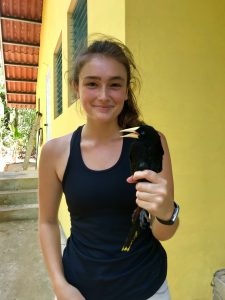
Studying birds has been a fundamental part of my life since I was a small child, roaming through my backwoods with binoculars in one hand and a small notebook in the other. My mother, an avid birder, poured birds into my childhood in any possible way she could manage. Yet my passion for these feathered creatures didn’t seem to ignite until my first year in undergrad, when I found myself standing atop Windmill Hill at Shelburne Farms, witnessing the sunrise over Lake Champlain with the rambling, robotic call of the Bobolink filling the empty spaces around me. This was my spark, in part because of the beauty of my surroundings, but also because this was something I had chosen to chase alone. I was forging my own path, finding my autonomy, journeying towards my own independence. And something about those quiet mornings moved me. The rush of endorphins I experienced whenever I found a nest with bald, pink, dinosaur heads peeking up at me was addicting. The feeling of a bird in my hand, with a small, weathered geolocator affixed to its back, was a humbling reminder of the lengths, the distances, the hardships that these birds endure every year just to continue living. I was hooked. And I needed to keep following this avidity.
I made it my mission to continue chasing and wrangling birds after undergrad. I left Maine feeling curious, feeling fidgety, feeling flighty. I wanted to continue down the path of avian research and I wanted to get lost in foreign places in the process. So, I did. I found myself high on the peaks of the White Mountains at 5:00 in the morning, surveying and recording the cacophony of bird songs around me. I found myself waist-deep in Jamaican mangroves tracking the movements of American Redstarts while dodging lethargic yet menacing crocodiles. I found myself scrambling up cliff-faces in Panama, with the Pacific Ocean lapping lazily behind me, just to see if a clump of twigs way up in the distance could possibly be a Lance-tailed Manakin nest. And just as migratory birds always return home after spending months away, I often found myself packing up my field pants and returning to Vermont, just to spend my early summer mornings setting up nets in misty, Bobolink-ridden hayfields. And I say I “found myself” because in those moments, in those places, with hours spent waiting for a single testy bird to fly into a net or for a doting mother to return to her nest, you have no choice, nothing else to do, but to find a home within your head, to let your brain, your thoughts, and your dreams run wild. By immersing myself so deeply in traveling, researching, and observing, I cultivated both a mental and an emotional relationship with the birds who find homes within my home – wherever that may be.
The Germans have a word for this restlessness that I experience; for the internal cue, the genetical powered urge to spread one’s wings and take flight. Zugunruhe. “Zug” translating to movement and migration, and “unruhe” translating to anxiety and restlessness. Multiple studies have shown that prior to migration, caged birds will begin to orient their small bodies towards the direction they know they need to travel in, and their feet begin to impatiently tap and dance in reckless anticipation. While my dancing feet brought me around the world, they also tamed a bit and guided me to my current chapter. I recently migrated home, to Maine, to channel all of this energy and passion and experience into obtaining my master’s degree in Wildlife Ecology at the University of Maine. It was time, I think, for me to fold in my wings, to take off my wandering shoes and to set up camp for a while. Time to take off my nomadic hat and stay in one place long enough to establish roots. As a human, I’ll never be completely wild, as birds are, but each minute I spend holding a bird, reading about them, chasing them, talking about them, I feel inches closer to flight. And, right now, that’s all that I need.
